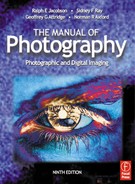0%
34Chapters
0-1Hours read
0kTotal Words
Book Description
The Manual of Photography is the standard work for anyone who is serious about photography - professional photographers and lab technicians or managers, as well as students and enthusiastic amateurs who want to become more technically competent. The authors provide comprehensive and accessible coverage of the techniques and technologies of photography.The Manual has aided many thousands of photographers in their careers. The ninth edition now brings this text into a third century, as the first edition dates from 1890.
Major new updates for the ninth edition include:
Coverage of digital techniques - more emphasis on electronic and hybrid media
Greater coverage of colour measurement, specification and reproduction - illustrated with a new colour plate section
Dealing with the fundamental principles as well as the practices of photography and imaging, the Manual topics ranging from optics to camera types and features, to colour photography and digital image processing and manipulation.
The authors write in a reader-friendly style, using many explanatory illustrations and dividing topics into clear sections.
Table of Contents
- Cover
- Half Title
- Title Page
- Copyright
- Contents
- Preface to the first edition of The Ilford Manual of Photography (1890)
- Preface to the ninth edition
- 1. Imaging systems
- 2. Fundamentals of light and vision
- 3. Photographic light sources
- 4. The geometry of image formation
- 5. The photometry of image formation
- 6. Optical aberrations and lens performance
- 7. Camera lenses
- 8. Types of camera
- 9. Camera features
- 10. Camera movements
- 11. Optical filters
- 12. Sensitive materials and image sensors
- 13. Spectral sensitivity of photographic materials
- Response of photographic materials to short-wave radiation
- Response of photographic materials to visible radiation
- Spectral sensitization
- Orthochromatic materials
- Panchromatic materials
- Extended sensitivity materials
- Infrared materials
- Other uses of dye sensitization
- Determination of the colour sensitivity of an unknown material
- Wedge spectrograms
- Spectral sensitivity of digital cameras
- 14. Principles of colour photography
- 15. Sensitometry
- The subject
- Exposure
- Density
- Effect of light scatter in a negative
- Callier coefficient
- Density in practice
- The characteristic (H and D) curve
- Main regions of the negative characteristic curve
- Variation of the characteristic curve with the material
- Variation of the characteristic curve with development
- Gamma-time curve
- Variation of gamma with wavelength
- Placing of the subject on the characteristic curve
- Average gradient and G
- Contrast index
- Effect of variation in development on the negative
- Effect of variation in exposure on the negative
- Exposure latitude
- The response curve of a photographic paper
- Maximum black
- Exposure range of a paper
- Variation of the print curve with the type of emulsion
- Variation of the print curve with development
- Requirements in a print
- Paper contrast
- The problem of the subject of high contrast
- Tone reproduction
- Reciprocity law failure
- Sensitometric practice
- Sensitometers
- Densitometers
- Elementary sensitometry
- Sensitometry of a digital camera
- 16. The reproduction of colour
- Colours of the rainbow
- Colours of natural objects
- Effect of the light source on the appearance of colours
- Response of the eye to colours
- Primary and complementary colours
- Complementary pairs of colours
- Low light levels
- Black-and-white processes
- Colour processes
- Formation of subtractive image dyes
- Colour sensitometry
- Imperfections of colour processes
- Correction of deficiencies of the subtractive system
- Masking of colour materials
- Problems of duplication
- The chemistry of colour image formation
- Chromogenic processes
- Silver-dye-bleach process
- Instant colour processes
- Alternative method for instant photography
- 17. Photographic processing
- Developers and development
- Developing agents
- Preservatives
- Alkalis
- Restrainers (anti-foggants)
- Miscellaneous additions to developers
- Superadditivity (synergesis)
- Monochrome developer formulae in general use
- Changes in a developer with use
- Replenishment
- Preparing developers
- Techniques of development
- Obtaining the required degree of development
- Quality control
- Processing following development
- Rinse and stop baths
- Fixers
- Silver recovery
- Bleaching of silver images
- Washing
- Tests for permanence
- Drying
- 18. Speed of materials, sensors and systems
- 19. Camera exposure determination
- Camera exposure
- Optimum exposure criteria
- Exposure latitude
- Subject luminance ratio
- Development variations
- Exposure determination
- Practical exposure tests
- Light measurement
- Exposure meter calibration
- Exposure values
- Incident light measurements
- Exposure meters in practice
- Photometry units
- Spot meters
- In-camera metering systems
- Electronic flash exposure metering
- Automatic electronic flash
- 20. Hard copy output media
- Hard copy output
- Photographic papers
- Type of silver halide emulsion
- Paper contrast
- Paper surface
- Paper base
- Colour photographic papers
- Processing photographic paper
- Pictrography and Pictrostat
- Dry Silver materials
- Cylithographic materials/Cycolor
- Thermal imaging materials
- Materials for ink-jet printing
- 21. Production of hard copy
- Photographic printing and enlarging
- Types of enlargers
- Light sources for enlarging and printing
- Lenses for enlargers
- Ancillary equipment
- Exposure determination
- Conventional image manipulation
- Colour printing
- Colour enlarger design
- Types of colour enlarger
- Methods of evaluating colour negatives for printing
- Digital output
- Evaluating the results
- 22. Life expectancy of imaging media
- 23. Colour matters
- 24. Theory of image formation
- 25. Images and information
- 26. Digital image processing and manipulation
- Index
